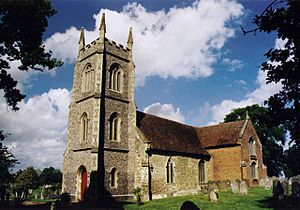Henry Hawley facts for kids
Quick facts for kids
Henry Hawley
|
|
|---|---|
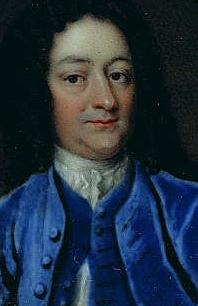 |
|
| Governor of Portsmouth | |
| In office 8 July 1752 – 24 March 1759 |
|
| Governor of Inverness | |
| In office 1748–1752 |
|
| Commander-in-chief, Scotland | |
| In office December 1745 – July 1746 |
|
| Personal details | |
| Born | 12 January 1685 Westminster, London |
| Died | 24 March 1759 (aged 74) West Green House, Hampshire |
| Resting place | St Mary's Church, Hartley Wintney |
| Relations |
|
| Military service | |
| Allegiance | |
| Branch | |
| Years of service | 1702–1748 |
| Rank | Lieutenant general |
| Unit | 4th Dragoons |
| Battles/wars | |
Henry Hawley (born 12 January 1685 – died 24 March 1759) was a British army officer. He served in many wars during the first half of the 1700s. He fought in important battles like the Capture of Vigo in 1719, Dettingen, Fontenoy, and Culloden.
During the Jacobite rising of 1745, Hawley was called back to Britain. He became the commander in Scotland in December 1745. In January 1746, he lost the Battle of Falkirk Muir, but this did not stop his career. The Duke of Cumberland then took command. Hawley led the cavalry at Culloden in April. This victory ended the Jacobite Rising.
Hawley was a brave and skilled cavalry leader. However, he was also very strict with his soldiers. People sometimes called him 'Hangman Hawley' because of his tough rules. After the Battle of Culloden, there were claims about harsh actions against wounded Jacobite soldiers. Hawley returned to Flanders in July 1746. When the War of the Austrian Succession ended in 1748, he became Governor of Inverness. In 1752, he became Governor of Portsmouth. He died in March 1759 near his home in Hartley Wintney.
Contents
Henry Hawley's Early Life
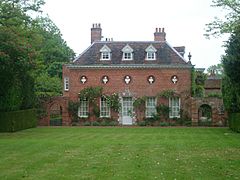
Henry Hawley was born in Westminster, London, and was baptized on 12 January 1685. His father, Francis Hawley, was a soldier who died in 1692. His mother was Judith Hughes. Henry had three siblings: Edward, Anne, and another son who died young.
Some stories claimed Henry Hawley was the secret son of King George II. However, historians have shown this was not true. King George II would have been only two years old when Henry was born.
When his father died, the family had no money. In 1694, Henry's uncle, Thomas Erle, helped him. He made Henry an ensign (a low-ranking officer) in the 19th Foot regiment. Henry was only nine years old at the time. Back then, army positions could be bought and sold. Children could even get commissions, though this was later stopped. Henry's brother Edward also became an officer. His mother received a pension to help the family.
Hawley never married. He had a long-term relationship with Elizabeth Toovey. In his will, he called her his "friend, companion, and careful nurse." Her second son, Captain William Toovey, became Hawley's heir. After Hawley's death in 1759, William took the name Hawley.
Military Career Highlights
Henry Hawley's father had been a Lieutenant-Colonel in the 4th Dragoons. This regiment was led by Queen Anne's husband, Prince George of Denmark. Henry became an attendant to their son, William of Gloucester. In 1702, when the War of Spanish Succession began, Henry joined Temple's Regiment. In 1704, Prince George helped him move to the Royal Horse Guards.
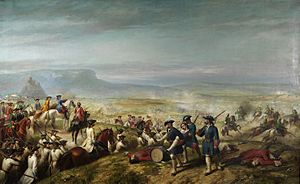
In 1706, Hawley became a captain in his father's old regiment. He went to Spain with his uncle Thomas Erle. He fought in the 1707 Battle of Almanza. This was a big defeat for the British and their allies. Most of the British foot soldiers were captured, but Hawley and the cavalry escaped. In 1708, he returned to England. In 1709, Hawley went back to his regiment in Scotland.
In 1710, Hawley had a fight with another officer and killed him in a duel. Duels were common back then. Queen Anne pardoned him and helped him become a lieutenant-colonel in 1712. In 1714, George I became king. During the Jacobite rising of 1715, Hawley and his younger brother Edward fought at Sheriffmuir.
In 1717, Hawley became Colonel of the 33rd Foot. In 1719, his regiment was part of a force that captured the Spanish port of Vigo. They took a lot of valuable goods, which made Hawley and other senior officers very rich. In 1720, he bought land near Hartley Whitney. He built West Green House there, which is now owned by the National Trust.
Britain was peaceful for the next 20 years. In 1730, Hawley became Colonel of the 13th Dragoons. He was promoted to major general in 1739. The next year, he returned to the 4th Dragoons as Colonel. He stayed in this role until he died in 1759. In 1741, he was offered command of British forces to capture Cartagena de Indias in the West Indies. He turned it down, perhaps because it was known to be a very unhealthy place. That expedition failed, with many soldiers dying from yellow fever.
Instead, he served in Flanders. He was second-in-command of the cavalry at the Battle of Dettingen in June 1743, which was a British victory. At Fontenoy in April 1745, Hawley took command of the cavalry. His actions helped the Allied foot soldiers retreat safely. Even though Fontenoy was a defeat, it improved his reputation.
The 1745 Jacobite Rising
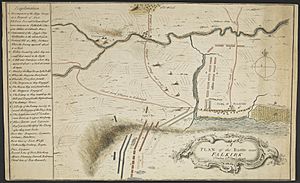
The Jacobite rising of 1745 began in July when Charles Edward Stuart landed in Scotland. In September, the Jacobites defeated Sir John Cope at Prestonpans. The Jacobite army then marched into England. They reached Derby on 4 December but then turned back to Scotland. This was because they did not get enough support from English or French allies. Hawley was among the troops sent back to Britain. He was at the Clifton Moor skirmish on 18 December. Two days later, he was made the commander in Scotland.
His main goal was to secure Lowland Scotland. On 6 January, Hawley arrived in Edinburgh. He had about 8,000 soldiers. The Jacobites were trying to capture Stirling Castle. On 13 January, Hawley sent 4,000 troops to help. Hawley thought his cavalry could easily defeat the Highland foot soldiers. He did not realize how strong the Highlanders were in battle.
This overconfidence led to his defeat at Falkirk Muir on 17 January. The battle began late in the afternoon in bad light and heavy snow. Hawley's cannons got stuck in the mud. His cavalry charged the Jacobite side but were pushed back. This caused confusion among his own foot soldiers. However, his right flank held its ground and managed to retreat in good order. The Highlanders stopped to take supplies, which helped Hawley's troops escape.

Neither Hawley nor the Duke of Cumberland saw Falkirk as a major defeat. However, many officers were lost because their men abandoned them. Some soldiers were punished, and a few were executed. Unlike Sir John Cope, Hawley was never put on trial for Falkirk.
Hawley led two regiments of cavalry at the Battle of Culloden on 16 April. The battle lasted less than an hour and was a clear victory for the government army. Many Jacobite soldiers were killed during the chase after the battle. This was a normal part of battles back then. Soldiers who stayed together, like the French troops, were safer than those who scattered. Many wounded Jacobite soldiers left on the battlefield were also killed.
James Wolfe, who was Hawley's assistant at Culloden, later spoke about these events. He said he refused an order to shoot a wounded Highland officer. It is unclear if this story is completely true. However, it is known that harsh actions against Jacobites took place after the battle. Wolfe himself later wrote that "as few Highlanders are made prisoner as possible."
Wolfe was known for criticizing his senior officers. In 1755, he said that soldiers "dread (Hawley's) severity, hate the man and hold his military knowledge in contempt." However, in 1748, the Duke of Cumberland said Hawley was his most skilled cavalry leader. Hawley's own papers show he was a thoughtful commander, not just a harsh one.
Later Life and Legacy
In July 1745, the Earl of Albemarle took over as commander in Scotland. Hawley returned to Flanders with the Duke of Cumberland. He stayed there until the War of the Austrian Succession ended. He fought in the 1747 Battle of Lauffeld. This was a French victory, where only brave cavalry charges saved the Allied foot soldiers. This battle ended Hawley's active military career. He remained Colonel of the 4th Dragoons until he died. In 1748, he became Governor of Inverness, a job that did not require much work.
In 1752, he was made Governor of Portsmouth, which was near his home. He died in March 1759. He was buried in St Mary's Church, Hartley Wintney. In his will, he left £5,000 to his sister Anne. He also left his properties to Elizabeth Toovey for her lifetime. After she died, these properties went to her second son, Captain William Toovey. William took Hawley's name, and his family owned West Green End until 1898.
Images for kids
| Military offices | ||
|---|---|---|
| Preceded by George Wade |
Colonel, 33rd Foot 1717–1730 |
Succeeded by Robert Dalzell |
| Preceded by Lord Harrington |
Colonel, 13th Dragoons 1730–1740 |
Succeeded by Robert Dalway |
| Preceded by 2nd Duke of Marlborough |
Colonel, 4th, later Royal Regiment of Dragoons 1740–1759 |
Succeeded by Henry Conway |
| Preceded by Roger Handasyd |
Commander-in-Chief, Scotland December 1745 – July 1746 |
Succeeded by 2nd Earl of Albemarle |
| Preceded by George Wade |
Governor of Inverness 1748–1752 |
Succeeded by Sir Charles Howard |
| Preceded by Philip Honywood |
Governor of Portsmouth 1752–1759 |
Succeeded by Lord Tyrawley |


